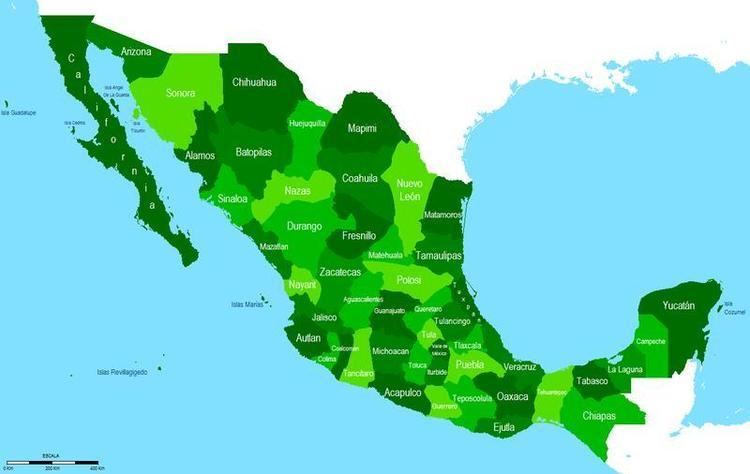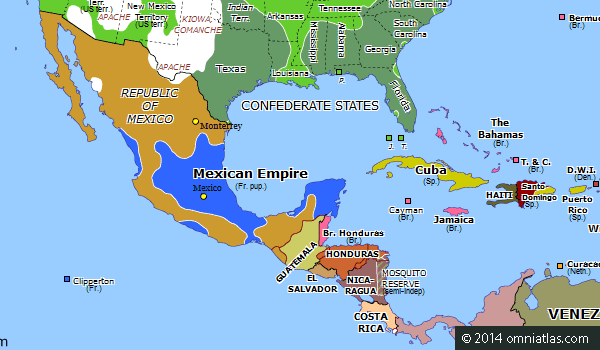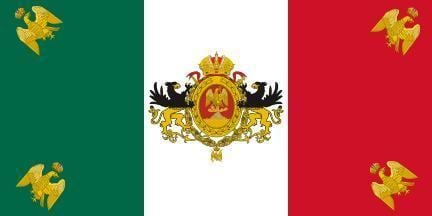Religion Roman Catholicism Area 1.973 million km² | Founded 1863 Date dissolved 1867 | |
 | ||
Government Federal constitutional monarchy | ||
The Mexican Empire (Spanish: Imperio Mexicano) or Second Mexican Empire (Spanish: Segundo Imperio Mexicano) was the name of Mexico under a limited hereditary monarchy declared by the Assembly of Notables on July 10, 1863, during the Second French intervention in Mexico. It was created with the support of Napoleon III of France, who attempted to establish a monarchist ally in the Americas. A referendum confirmed the coronation of the Austrian Archduke Ferdinand Maximilian, of the House of Habsburg as Emperor Maximilian I of Mexico.
Contents

Promoted by the powerful and conservative elite of Mexico's "hacendados", with the support of the French, as well as from the Austrian and Belgian crowns, the intervention attempted to create a monarchical system in Mexico, as it had functioned during the 300 years of the viceroyalty of New Spain and for the short term of the imperial independent reign of Emperor Agustin I of Mexico. Support came mainly from conservative Catholics, which were at the time majority within Mexico, and the main means came from the Mexican nobility, who aimed to promote stability and end the constant cycle of unrest and revolution that had come to a terrible situation with the government of Benito Juárez. The Empire came to an end on June 19, 1867, with the execution of Emperor Maximilian I.

History

The rule of Emperor Maximilian was blemished by constant conflict. On his arrival in 1864 with his wife, Empress Carlota of Mexico, daughter of King Leopold I of the Belgians, he found himself in the middle of a political struggle between the Conservatives that backed him and the opposing Liberals, headed by Benito Juárez. The two factions had set up parallel governments; the Conservatives in Mexico City controlling central Mexico and the Liberals in Veracruz. The Conservatives received funding from Europe, especially from Isabella II of Spain and Napoleon III of France; the Liberals found backing from United States Presidents Abraham Lincoln and Andrew Johnson, after they had finished their own Civil War in 1865.

The United States government viewed Emperor Maximilian as a French puppet, and did not regard his reign as the will of most Mexicans or see him as the legitimate leader of Mexico. They demanded the withdrawal of French forces, and France acceded. In 1867, the empire fell and Maximilian was executed at the orders of Benito Juárez, in the Cerro de las Campanas near Querétaro.
Maximilian proved to be too liberal for the conservatives, and too conservative for the liberals. He regarded Mexico as his destiny and made many contributions. Before his death, Maximilian adopted the grandsons of the first Mexican emperor, Agustín de Iturbide: Agustín de Iturbide y Green and Salvador de Iturbide y Marzán.
Role of France
Napoleon III had more ambitious goals in mind than merely the recovery of France's debts. Heavily influenced by his wife the Empress Eugenie, he was bent on reviving the Mexican monarchy. Prior to 1861 any interference in the affairs of Mexico by any of the European powers would have been viewed as a challenge to the United States and no one wanted to provoke a conflict with them. However, in 1861 the United States was embroiled in its own bloody conflict, the American Civil War, which made the government in Washington powerless to intervene. Encouraged by the Empress Eugenie, who saw herself as the champion of the Catholic Church in Mexico, Napoleon III took advantage of the situation.
Napoleon III saw the opportunity to make France the great modernizing influence in the Western Hemisphere as well as enabling the country to capture the South American markets. To give him further encouragement, there was his half brother, the duc de Morny, who was the largest single holder of Mexican bonds.
Chronology
Territorial division
The Empire was divided into 50 departments (departamentos):
Legacy
Today, the Second Mexican Empire is advocated by small far right groups like the Nationalist Front of Mexico, whose followers believe the Empire to have been a legitimate attempt to deliver Mexico from the hegemony of the United States. They are reported to gather every year at Querétaro, the place where Maximilian and his generals were executed.
In popular culture
The 1970 film Two Mules for Sister Sara was set in Mexico during the years of the Second Mexican Empire. The two main characters, played by Clint Eastwood and Shirley MacLaine, aided a Mexican resistance force and ultimately led them to overpower a French garrison.
The 1969 film The Undefeated starring John Wayne and Rock Hudson portrays events during the French Intervention in Mexico and was also loosely based on the escape of Confederate General Sterling Price to Mexico after the American Civil War and his attempt to join with Maximilian's forces.
The 1965 film Major Dundee starring Charlton Heston and Richard Harris featured Union cavalry (supplemented by Galvanized Yankees) crossing into Mexico and fighting French forces towards the end of the American Civil War.
The 1954 film Vera Cruz was also set in Mexico and has an appearance of Maximilian having a target shooting competition with Gary Cooper and Burt Lancaster's character at Chapultepec Castle. Maximilian was played by George Macready, who at 54 was twenty years older than the Emperor was in 1866.
The 1939 film Juarez featured Paul Muni as Benito Juárez, Bette Davis as Empress Carlota, and Brian Aherne as Emperor Maximilian. It was based, in part, on Bertita Harding's novel The Phantom Crown (1937).
In the Southern Victory Series of alternate history novels by Harry Turtledove, Maximilian's Empire survives the turmoil of the 1860s into the 20th century due to the Confederate States of America emerging victorious over the United States of America in the "War of Secession"; thus, the United States becomes too weak and unwilling to pressure Maximilian's puppet state to capitulate to rebels and dissolve. It fights alongside the Confederate States against the United States in 1881-1882, 1914-1917 and 1941-1944.
In Mexican popular culture, there have been soap operas like "El Carruaje" (1967), plays, films, and historical novels such as Fernando del Paso's Noticias del Imperio (1987). Biographies, memoirs, and novels have been published since the 1860s, and among the most recent have been Prince Michael of Greece's The Empress of Farewells, available in various languages.
